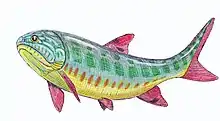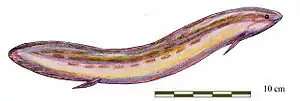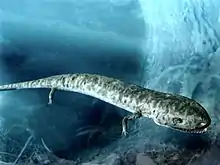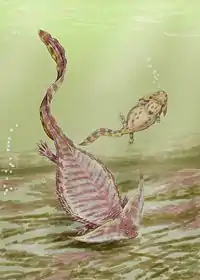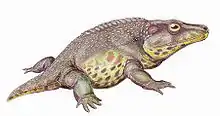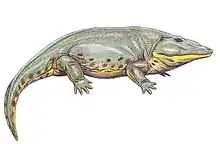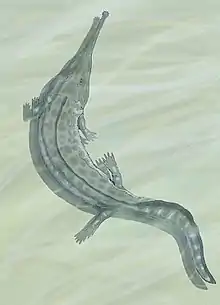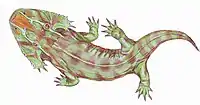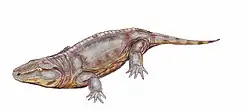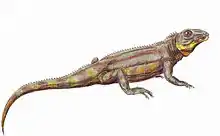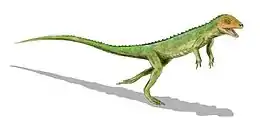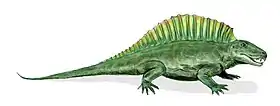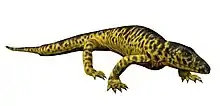Kungurian
In the geologic timescale, the Kungurian is an age or stage of the Permian. It is the latest or upper of four subdivisions of the Cisuralian epoch or series. The Kungurian lasted between 283.5 and 272.95 million years ago (Ma). It was preceded by the Artinskian and followed by the Roadian.[2] It corresponds roughly to the Leonardian stage, covering the span from 280 to 270.6 ± 0.7 Ma in the North American system.[3]
| Kungurian | |
|---|---|
| 283.5 ± 0.6 – 272.95 ± 0.11 Ma | |
| Chronology | |
Key events in the Permian -300 — – -295 — – -290 — – -285 — – -280 — – -275 — – -270 — – -265 — – -260 — – -255 — – -250 — An approximate timescale of key Permian events. Axis scale: millions of years ago. | |
| Etymology | |
| Name formality | Formal |
| Usage information | |
| Celestial body | Earth |
| Regional usage | Global (ICS) |
| Time scale(s) used | ICS Time Scale |
| Definition | |
| Chronological unit | Age |
| Stratigraphic unit | Stage |
| Time span formality | Formal |
| Lower boundary definition | Not formally defined |
| Lower boundary definition candidates | Near FAD of the Conodont Neostreptognathodus pnevi |
| Lower boundary GSSP candidate section(s) | Southern Ural mountains |
| Upper boundary definition | FAD of the Conodont Jinogondolella nanginkensis |
| Upper boundary GSSP | Stratotype Canyon, Guadalupe Mountains, Texas, U.S.A. 31.8767°N 104.8768°W |
| GSSP ratified | 2001[1] |
Stratigraphy
The Kungurian is named after the Russian city of Kungur in Perm Krai. The stage was introduced into scientific literature by Russian geologist Alexandr Antonovich Stukenberg (Alexander Stuckenberg) in 1890.[4]
The base of the Kungurian stage is defined as the place in the stratigraphic record where fossils of conodont species Neostreptognathodus pnevi and Neostreptognathodus exculptus first appear. As of 2009, there was no agreement yet on a global reference profile (a GSSP) for the base of the Kungurian. The top of the Kungurian (the base of the Roadian and the Guadalupian series) is defined as the place in the stratigraphic record where fossils of conodont species Jinogondolella nanginkensis first appear.
The Kungurian contains three conodont biozones:
- zone of Neostreptognathodus sulcoplicatus
- zone of Neostreptognathodus prayi
- zone of Neostreptognathodus pnevi
Kungurian Life
Chondrichthyans
| Chondrichthyes of the Kungurian | ||||
|---|---|---|---|---|
| Taxa | Presence | Location | Description | Images |
| Cisuralian | Russia, Australia, Japan | A eugeneodont holocephalian, "buzzsaw shark" |
| |
| Cisuralian | United States | A ctenacanthtiform | ||
|
Cisuralian | United States | A petalodontiform holocephalian | |
| Cisuralian | Russia, Bolivia | A eugeneodont holocephalian | ||
Actinopterygians
| Actinopterygii of the Kungurian | ||||
|---|---|---|---|---|
| Taxa | Presence | Location | Description | Images |
| Carboniferous to Lopingian | Germany, England | A non-neopterygian |
| |
|
Cisuralian | United States | ||
| Cisuralian | Kazakhstan | A non-neopterygian | ||
Lungfishes
| Dipnoi of the Kungurian | ||||
|---|---|---|---|---|
| Taxa | Presence | Location | Description | Images |
| Carboniferous to Early Triassic | United States |
| ||
| Carboniferous to Cisuralian | United States | |||
†Lepospondyls
| Lepospondyli of the Kungurian | ||||
|---|---|---|---|---|
| Taxa | Presence | Location | Description | Images |
| Cisuralian | United States |
| ||
|
North America | |||
†Temnospondyls
| Temnospondyli of the Kungurian | ||||
|---|---|---|---|---|
| Taxa | Presence | Location | Description | Images |
| Early Permian | United States | A diverse genus of basal dissorophids. |
| |
| Texas, Oklahoma, China and Russia | A dissorophid known from multiple specimens. | |||
| Inta Formation, Russia | An eryopid. | |||
| United States | A dissorophid known from multiple specimens. | |||
| Cisuralian | Texas, United States | A large eryopid temnospondyl. Eryops averaged a little over 1.5–2.0 metres long and could grow up to 3 metres (9.8 ft), making them among the largest land animals of their time. | ||
| Pedra do Fogo Formation, Parnaíba Basin, Brazil | A gigantic archegosaurid, estimated at about 9 metres in length and over 2 tonnes of weight, it is currently the largest known amphibian to have ever lived. | |||
| Piaui, Brazil | A genus of dvinosaurian within the family Trimerorhachidae. | |||
| Inta Formation, Russia | An eryopid. | |||
| Piaui, Brazil | A genus of dvinosaurian. | |||
| Abo Formation, New Mexico and Seymour, Baylor County, Texas | A genus of dvinosaurian within the family Trimerorhachidae. | |||
| Cisuralian | Texas, New Mexico, Oklahoma, United States | A zatracheidid | ||
†Seymouriamorphs
| Seymouriamorpha of the Kungurian | ||||
|---|---|---|---|---|
| Taxa | Presence | Location | Description | Images |
| Boskovice Furrow, Czech Republic | A reptiliomorph |
| ||
|
Seymour, Baylor County, Texas among others in North America | A reptiliomorph | ||
†Diadectomorphs
| Diadectomorpha of the Kungurian | ||||
|---|---|---|---|---|
| Taxa | Presence | Location | Description | Images |
| North America | A diadectid reptiliomorph |
| ||
†Procolophonomorphs
| Procolophonomorpha of the Kungurian | ||||
|---|---|---|---|---|
| Taxa | Presence | Location | Description | Images |
| middle Kungurian | Oklahoma, USA | A parareptile. |
| |
| Cisuralian | Europe | A genus of lizard-shaped parareptile | ||
| Cisuralian | North America and North Asia | A genus of biped lizard-shaped parareptile | ||
| Cisuralian | Germany | A genus of biped lizard-shaped parareptile | ||
Eureptilians
| Eureptilia of the Kungurian | ||||
|---|---|---|---|---|
| Taxa | Presence | Location | Description | Images |
| Cisuralian | North America and Europe | A captorhinid reptile |
| |
| Cisuralian | North America | A captorhinid reptile | ||
| Cisuralian | North America | A captorhinid reptile | ||
Synapsids
| Synapsida of the Kungurian | ||||
|---|---|---|---|---|
| Taxa | Presence | Location | Description | Images |
| Cisuralian | Texas, USA | A caseasaurian |
| |
| Cisuralian | Texas, USA and Aveyron, France | A caseasaurian | ||
| Cisuralian | Greene Formation, Ohio; Belle Plains Formation, Texas; Cutler Formation, Utah, all in the USA | A caseasaurian | ||
|
Sakmarian-Kungurian |
Greene Formation, Ohio; Belle Plains Formation, Texas; Cutler Formation, Utah, all in the USA |
A sphenacodontid | ||
| Cisuralian | United States, Canada | A sphenacodontid | ||
| Cisuralian | United States | An edaphosaurid | ||
| Cisuralian | United States | A varanopid | ||
| Kasimovian-Kungurian | Kenilworth, Kenilworth Sandstone Formation, Warwickshire Group, Warwickshire, England; Autun, France, Cutler Formation, Arizona, Colorado, New Mexico and Utah; Fort riley, Chase Group, Kansas, Greene Formation, Dunkard Group, Ohio; Wellington Formation, Oklahoma; Clyde Formation, Texas and Oklahoma; Admiral Formation; Belle-Plains Formation; Wichita Group, all three in Texas, | An ophiacodontid | ||
| Wichita Group and Clear Fork Group, both in Texas, USA | A sphenacodontid | |||
| Cisuralian | United States | Possibly the oldest and most primitive therapsid, most likely it was a more basal sphenacodont instead. | ||
| Cisuralian | Texas, Oklahoma, United States | A varanopid | ||
References
- "GSSP for Roadian Stage". International Commission on Stratigraphy. International Commission on Stratigraphy. Retrieved 13 December 2020.
- Gradstein, F.M.; Ogg, J.G. & Smith, A.G.; 2004: A Geologic Time Scale 2004, Cambridge University Press
- Rohde, Robert A. "Leonardian North American Stage". GeoWhen Database. Retrieved December 10, 2012.
- Chuvashov, B.I.; Chernykh, V.V.; Leven, E.Y.; Davydov, V.I.; Bowring, S.A.; Ramezani, J.; Glenister, B.F.; Henderson, C.M.; Schiappa, T.A.; Northrup, C.J.; Snyder, W.S.; Spinosa, C. & Wardlaw, B.R.; 2002: Progress report on the base of the Artinskian and base of the Kungurian by the Cisuralian Working Group, Permophiles 41: pp 13–16.
External links
- GeoWhen Database - Kungurian
- Upper Paleozoic stratigraphic chart at the website of the subcommission for stratigraphic information of the ICS


